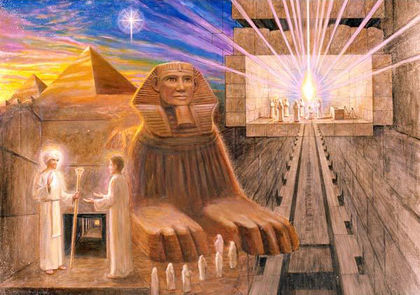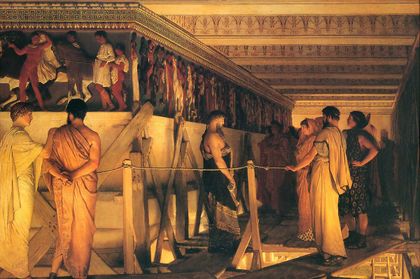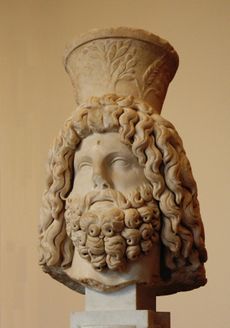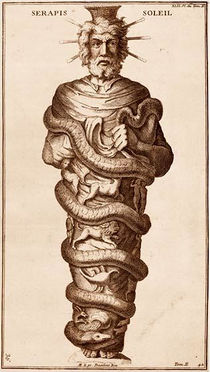Serapis Bey

Serapis Bey es el chohán del cuarto rayo, jerarca del Templo de la Ascensión, en Lúxor, y el decimotercer miembro del Consejo de Adeptos del Templo de la Ascensión. También es conocido como Serapis Soleil, Serapis del Sol.
El cuarto rayo es la llama de la ascensión, la luz blanca de la Madre en el chakra de la base de la columna. De esa luz blanca surge la arquitectura, los principios de las matemáticas, los cimientos de la construcción del templo de la Materia y la pirámide del Yo. Ante la presencia de Serapis, uno conoce una concepción completamente distinta de lo que llamamos el Cristo, la persona real en todos nosotros.
Embodiments
Conocido como el Gran Disciplinario, Serapis llegó desde Venus con el Anciano de Días para volver a encender el fuego sagrado en el corazón de una humanidad rebelde. Su gran entusiasmo por recuperar a los hijos del hombre como reyes y sacerdotes para Dios se hinchó y se elevó comouna llama de voluntad, determinación y disciplina férrea.
Sumo sacerdote en el Templo de la Ascensión
Serapis fue un sacerdote del Templo de la Ascensión de la Atlántida. Como guardián de la llama de la ascensión, llevó la llama por el río Nilo salvaguardándola hasta Lúxor, justo antes de que se hundiera la Atlántida. Con sus propias palabras, Serapis nos ofrece un vislumbre de esta experiencia:
Recuerdo bien cuando se produjeron los primeros estruendos del hundimiento de la Atlántida. Porque, como sabéis, el hundimiento de ese continente llegó por etapas. Por la gracia de Dios, se dio un aviso que permitió que muchos escaparan. Y nosotros nos dirigimos a Lúxor…
Os preguntaréis por qué una llama espiritual necesita ser transportada por simples mortales. Siempre ocurre que los niños de la luz tienden a pensar que tales cosas deben suceder mágica y milagrosamente. Quizá algo del cuento de hadas se ha derramado sobre la religión y la gente se ha olvidado de que todo lo que ha sido forjado por Dios y el hombre ha sido un trabajo y un esfuerzo conjunto, arriba y abajo.
Os diré, pues, por qué esto es así: porque el único sitio en el que la llama puede morar, además del altar dedicado a eso, es el corazón vivo del adepto vivo[1].
En Egipto, Serapis y los hermanos que le acompañaban construyeron el Templo de la Ascensión; y ahí han protegido la llama desde entonces, alternándose en sus deberes mientras reencarnaban con ese único propósito.
Serapis Bey continuó reencarnando en la tierra del Nilo, renunciando a su propia ascensión hasta aproximadamente 400 a.C. Durante esas vidas llegó a ser el patrocinador de algunas de las proezas arquitectónicas más importantes que jamás se han producido en la Tierra.
Arquitecto de la Gran Pirámide

Serapis fue el arquitecto de la Gran Pirámide y El Morya fue el maestro constructor. La Gran Pirámide es la talla en piedra del registro del sendero de iniciación por el que el alma, comenzando en la Materia, la base de la pirámide, los cuatro lados, se eleva desde el centro de la pirámide hasta la cúspide. La elevación de esa llama es la meditación sobre la luz blanca que viaja en el cuerpo físico desde la base de la columna hasta la coronilla.
Jesús y El Morya explican que «la construcción de la pirámide del Yo es una construcción interior, pero la ecuación exterior debe conformarse, debe mostrar frutos, debe establecer el ejemplo para que otros puedan seguiros hasta el corazón de la Esfinge, hasta el mismísimo corazón del Gurú vivo, a quien representa la Esfinge, y hasta el corazón de la llama en la Gran Pirámide que está en la octava etérica (y no se encuentra en la pirámide de Giza, que es el cascarón que queda de su anterior foco y función debido al abuso de su energía por magos negros, falsos gurús y falsos chelas)»[2]
Amenofis III

Serapis estuvo encarnado como el faraón egipcio Amenofis III (reinó de 1417 a 1379 a.C. aprox.), hijo de Tutmosis IV y biznieto de Tutmosis III, una encarnación de Kuthumi. Su hijo y sucesor al trono fue Amenofis IV, más tarde conocido como Akenatón. Durante el reinado de Serapis Egipto estaba en la cumbre de la prosperidad, la paz y el esplendor, que eran la manifestación directa de la comunión de Serapis con su llama del corazón y con los maestros ascendidos, hasta llegar al Anciano de Días.
Amenofis III estaba considerado como el gobernante más grande de la Tierra. Mantuvo un alto nivel en las relaciones diplomáticas de paz con todos los países, durante la mayor parte de su reinado. Parte de la gran riqueza de su tesorería se gastó en la construcción de magníficos templos y palacios. Agrandó el ya existente Templo de Karnak del Nilo y construyó un gigantesco templo funerario, cuyos restos son conocidos actualmente como los Colosos, las estatuas monolíticas sentadas, descubiertas en la ribera. Quiso exteriorizar en piedra el conocimiento del orden jerárquico de iniciados, de maestros ascendidos, de reyes filósofos que habían caminado por la Tierra en la anteriores eras de oro.
Su construcción más importante fue la del templo de Lúxor, que permanece parcialmente intacto. Este templo encarnaba en su geometría y diseño la representación física de la ley esotérica que había sido transmitida a través del sacerdocio durante generaciones. Permanece como un libro de texto completo de ciencia, arte y filosofía avanzada. El templo de Lúxor es hoy el equivalente físico del retiro etérico que es el Templo de la Ascensión.
Leónidas
► Artículo principal: Termópilas
Serapis también encarnó como el rey espartano Leónidas (murió hacia 480 a.C.), que estuvo al mando de los griegos en su heroica resistencia contra la inmensa invasión Persa en el paso de las Termópilas, entrada a la Grecia central.
Aunque los persas tenían muchos más hombres que los griegos, Leónidas resistió el avance del ejército persa, bajo el rey Jerjes, durante dos días. Al tercero, cuando los persas se acercaron por la retaguardia y no hubo refuerzos a la vista, Leónidas despidió a la mayoría de sus hombres. Ayudado por los aliados griegos que quedaban, Leónidas y su guardia real espartana de trescientos hombres lucharon hasta el final. Su heroica resistencia permitió a la flota griega realizar una retirada para después derrotar a los persas. El ejemplo de Leónidas ha servido para dar continuidad a la chispa de identidad nacional de la nación griega.
Los historiadores citan esta batalla como un gran ejemplo de valor e intrepidez en la lucha por una causa con poquísimas posibilidades de éxito. El registro akáshico revela que los trescientos espartanos eran un reagrupamiento de trescientos chelas de Lúxor que estaban encarnados con Serapis. Tenían un tipo de hombría extraordinario. Actualmente algunos son maestros ascendidos, otros siguen encarnados.
En aquella época, la guerra era una guerra física contra dificultades físicas. Hoy tenemos la batalla de Armagedón contra maldades espirituales en altos puestos en la Iglesia y el Estado; la mente de Dios que consume lo contrario a la mente, el gran Yo que consume el yo irreal.
Fidias

Serapis Bey estuvo encarnado como el escultor Fidias, durante el siglo V a.C., en Atenas. Estaba considerado como el mayor de todos los escultores griegos. Fue el arquitecto del Partenón, supervisando su exquisita construcción maestra. En el Partenón colocó su obra más famosa, la estatua de cuarenta pies de oro y marfil de Palas Atenea, la representación de la figura de la Madre, la Diosa de la Verdad.
En el Partenón nos encontramos ante una obra arquitectónica diseñada por alguien que sabe cómo usar la forma, la simetría, la geometría, los ángulos, para acoger la llama. El campo energético del Partenón contiene una llama esencial, igual que el Templo de Lúxor y la Gran Pirámide.
Fidias también creó una enorme estatua de Zeus en oro y marfil, que estaba en el templo de Olimpia. Fidias también era pintor, grabador y maestro de metalistería. Su arte se caracterizaba por su exaltada belleza y espiritualidad. Vivió como la suprema personificación de la era de oro de los maestros artistas griegos que tuvieron una influencia permanente en todo el arte occidental posterior.
As far as we know, Serapis Bey ascended about 400 B.C.
Adoración en Egipto

In the Hellenistic age, from 323 to 31 B.C., Serapis became one of the most important gods of the Egyptian and Greco-Roman pantheons. He was revered as the patron of the Ptolemaic kings of Egypt and as the founding deity of the great city of Alexandria. There are numerous historical records of the intimate contact of Serapis with men throughout Egypt and Asia Minor, and there are over 1,080 statues, temples and monuments dedicated to Serapis Bey that were erected during that era.
Demetrius of Phalarum, the founder of the Alexandrian library under Ptolemy I, was miraculously cured of blindness by Serapis and wrote hymns of thanksgiving. Serapis often spoke through oracles and gave counsel as well as personal, miraculous healings to many people. There is a famous historical account involving Serapis that marked an important era in the establishment of him as the most prominent deity of Egypt and Greece. King Ptolemy I, ruler of Egypt, was visited in a dream by Serapis, who commanded the king to bring the god’s statue to Alexandria. After vacillation and a second dream with Serapis, the king had the statue brought with the blessings of the Delphic Oracle and installed it in the Serapium, or great Temple, of Alexandria. This is the temple that contained the famous Alexandrian library of three hundred thousand volumes.
Many epithets are ascribed to Serapis, including “Father,” “Saviour” and “the greatest of the deities.” He was regarded as the sponsor of intimate contact between the gods and mortals. Serapis is regarded in the annals of the esoteric tradition as the hierophant of the secret Egyptian initiatory rites. The lesser mysteries were dedicated to Isis and intended for the layman; the greater mysteries were dedicated to Serapis and Osiris and transmitted only to initiated priests who underwent severe rites of trial and initiation in the temple of Serapis.
Over a period of six to seven hundred years, Serapis became the supreme deity of Egypt and Greece. However, in the late fourth century A.D., the emperor Theodosius issued edicts against polytheism, and Christians took this as license to attack pagans, including the adherents of mystery religions. The Christian Bishop of Alexandria provoked mobs to destroy the great symbol of paganism in Alexandria, the mystery temple of the god Serapis. They hacked apart the huge statue of Serapis, which had inspired worshipers for six hundred years. The mob destroyed at least one of Alexandria’s great libraries.
Work with the Theosophical Society

Serapis Bey played a vital role in the initial thrust and direction of the endeavors of the Brotherhood during the nineteenth century. Among the earliest letters from the adepts and masters to the founders of the Theosophical Society were those of Serapis Bey and the Brotherhood of Luxor.
Serapis took personal charge of the direction and chelaship of the amanuensis Helena Blavatsky and of Colonel Henry Steel Olcott, who was the co-founder and the president of the Theosophical Society. During the six months preceding the formation of the society in 1875, Serapis sent many letters of encouragement and instruction to Colonel Olcott. The letters were written mostly on thick green parchment in gold ink, signed by Serapis in script, and inscribed with an esoteric symbol of the Brotherhood of Luxor.
It is characteristic of the letters written to Henry Olcott that he continually gave the exhortation to him, “Try.” The master Serapis stressed the need for courage and fearlessness, the same strong traits he outpictured as Leonidas.
Serapis’ mission today
The ascended master Serapis Bey today occupies a very key position among the seven chohans. The fourth ray is midpoint between three on one side and three on the other. The center figure of four is key because it is the merging of the white light and the nexus of the figure-eight flow of energy. This point of the Mother flame is always embodied in the guru East or West, the person of the Mother in Sanat Kumara who moves in and among us by that white light.
The white light is the sacred fire of creation, and its perversion becomes black magic. This was seen in Egypt, the focal point of the ascension flame, as the practice of black magic by the Egyptian Black Brotherhood that went on for centuries upon centuries in defiance of the very presence of Serapis Bey within his temple.
The point of redemption of earth goes back to Lemuria, the Motherland and the Mother flame itself. Earth has a tremendous karma with the Mother flame and in the perversions of the Mother flame that took place on Lemuria, in the area of where San Francisco is now located and off the coast of California. The perversions of the Mother light opened the way for the desecration of the temples, the fall of the priests and priestesses, ultimately ending in misuse of the sexual energies and perversions of the life force. The final act was the murder of the highest representative of the Mother on Lemuria. The real cause of the sinking of Lemuria was the desecration of the person of the Mother and her flame.
Since that hour, earth has been slowly coming to the age of Aquarius when once again the light of the Mother could be raised up in all, both male and female, bringing about once again the honoring of the woman and of the Mother and a reunion of the Mother, the light rising from the base, with the light of the Father that descends out of the I AM Presence. The next two thousand years is destined to see the raising up of consciousness such as has not occurred since the golden ages of Lemuria.
The path of the ascension is the resolution of those forces that are necessary within our consciousness—Father, Mother, Son and Holy Spirit as the four pillars of the temple within us. Gautama Buddha’s great lesson was that all suffering is caused by being out of alignment with the inner light through wrong desire. Serapis Bey teaches us how to get into alignment with the inner will of Being. His teachings become the keystone in the arch of hierarchy. Without the white light, we cannot enjoy the integration of selfhood.
Serapis Bey, then, becomes a very important key at a time when there are so many problems in society. The increase in crime, murder, rape, drugs, and so forth is the sign of the coming of the Mother light, rising from the altars of Lemuria. The rising light becomes so intense that, unless we dive into it and become a part of it, it becomes the rock that Jesus spoke of—unless we fall upon that rock and allow our misconceptions to be broken, it breaks us.[3]
It is the light that resolves identity, but is also the light that is so powerful that it can destroy the false identity that rebels against it. At the dawning of the age of Aquarius, the world is in rebellion against the light of God, and yet the world is seeking God. The teaching of Serapis Bey and the mysteries of the Brotherhood of Luxor contain the answers that can resolve these questions.
Serapis Bey has legions of seraphim in his command. He has great attainment in divine geometry and design. He assists his disciples in the self-disciplines that are necessary for the ascension: the discipline of the four lower bodies in order that the Christ may appear and use them as vehicles for service and attainment in the world of form; the disciplining of past momentums of negative spirals and of human creation that would stand in the way of the ascension flame forming within the heart of everyone evolving upon the planet through the acceleration of the threefold flame.
The path of the ascension
His book Dossier on the Ascension is a textbook on the path of the ascension. It contains teachings from the classes he conducts at the Ascension Temple, and through it, you can have anchored in your conscious mind that which you learn at the Ascension Temple at Luxor while your body sleeps at night. He outlines the requirements of the ascension and provides a thorough explanation and instruction on the process of the ascension.
Serapis describes what happens during the ritual of the ascension:
It is true, although the form of an individual may show signs of age prior to his ascension, that all of this will change and the physical appearance of the individual will be transformed into the glorified body. The individual ascends, then, not in an earthly body but in a glorified spiritual body into which the physical form is changed on the instant by total immersion in the great God flame.
Thus, man’s consciousness of the physical body ceases and he achieves a state of weightlessness. This resurrection takes place as the great God flame envelops the shell of human creation that remains and transmutes, in a pattern of cosmic grids, all of the cell patterns of the individual—the bony structure, the blood vessels and all bodily processes, which go through a great metamorphosis.
The blood in the veins changes to liquid golden light; the throat chakra glows with an intense blue-white light; the spiritual eye in the center of the forehead becomes an elongated God flame rising upward; the garments of the individual are completely consumed, and he takes on the appearance of being clothed in a white robe—the seamless garment of the Christ. Sometimes the long hair of the Higher Mental Body [the Holy Christ Self] appears as pure gold on the ascending one; then again, eyes of any color may become a beautiful electric blue or a pale violet....
Lighter and lighter grows the physical form, and with the weightlessness of helium the body begins to rise into the atmosphere, the gravitational pull being loosened and the form enveloped by the light of the externalized glory which man knew with the Father “in the beginning” before the world was....
These changes are permanent, and the ascended one is able to take his light body with him wherever he wishes, or he may travel without the glorified spiritual body. Ascended beings can and occasionally do appear upon earth as ordinary mortals, putting on physical garments resembling the people of earth and moving among them for cosmic purposes. This Saint Germain did after his ascension when he was known as the Wonderman of Europe. Such an activity is a matter of dispensation received from the Karmic Board.[4]
(Generally, however, ascended beings do not return to the physical plane unless there is some specific service requiring this change in vibratory rate.)
Serapis tells us, “You ascend daily.” Our thoughts, our feelings, our daily deeds are all weighed in the balance. We do not ascend all at once, but by increments as we pass our tests and win our individual victories. The entire record of all our past lives and momentums of both good and evil must be counted; and then, when we have brought at least 51 percent of all the energy that has ever been allotted to us into balance with the purity and harmony of the Great God Self, we may be offered the gift of the ascension. The remaining 49 percent must be transmuted, or purified, from the ascended octaves through service to earth and her evolutions.[5]
Serapis Bey, the chohan of the ascension flame and hierarch of the Ascension Temple at Luxor, Egypt, speaks to each one of us:
The future is what you make it, even as the present is what you made it. If you do not like it, God has provided a way for you to change it, and the way is through the acceptance of the currents of the ascension flame.[6]
Guiseppe Verdi captured the music of the ascension flame in the “Triumphal March” from Aïda. The keynote of the Ascension Temple is “Liebestraum,” by Franz Liszt, and the radiance of the Electronic Presence of Serapis Bey and his twin flame pour through the aria “Celeste Aïda.”
See also
For more information
Mark L. Prophet and Elizabeth Clare Prophet, Lords of the Seven Rays.
Serapis Bey, Dossier on the Ascension.
Sources
Mark L. Prophet and Elizabeth Clare Prophet, The Masters and Their Retreats, s.v. “Serapis Bey.”
- ↑ Serapis Bey, “The Mobilization of Spiritual Forces (La movilización de fuerzas espirituales)”, Perlas de Sabiduría, vol. 25, núm. 60.
- ↑ Jesús y El Morya, “The Order of the Good Samaritan (La orden del Buen Samaritano)” Perlas de Sabiduría, vol. 27, núm. 52, 28 de octubre de 1984.
- ↑ Matt. 21:44; Luke 20:18.
- ↑ Serapis Bey, Dossier on the Ascension, pp. 158, 176–77.
- ↑ In addition to balancing 51 percent of one’s karma, the requirements for the ascension are to balance the threefold flame, align the four lower bodies, attain a certain mastery on all seven rays, achieve a degree of mastery over outer conditions, fulfill one’s divine plan, transmute the electronic belt, and raise the Kundalini.
- ↑ Ibid., p. 89.
